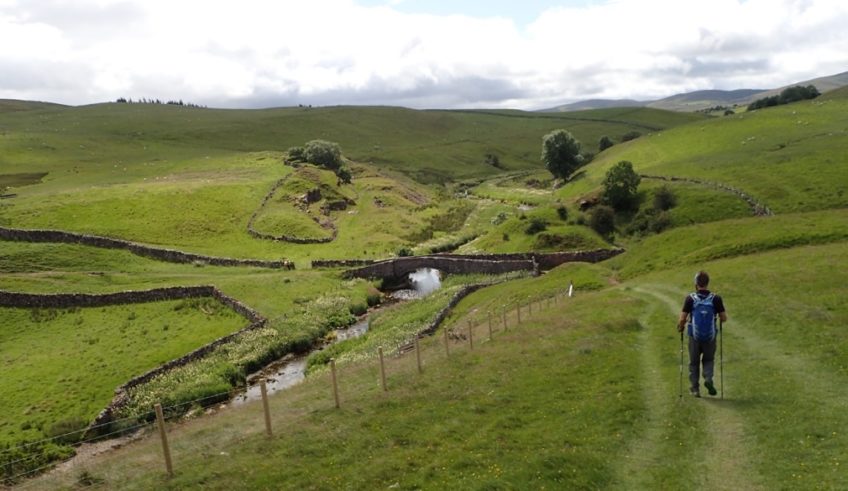Surprisingly, we awoke to overcast skies, spitting rain, and chilly temperatures… What’s new. Happily, by the time we had finished breakfast, the rains had largely subsided and the sun was beginning to poke holes through the clouds. It was the beginning of another beautiful day on the Coast to Coast.
From our hotel, we hopped onto the public byways, walking through a tight walled hedge that was barely shoulders width apart until we climbed over a wall into open pastures. The scene was not so different than yesterday, but the light was magical and the ground soft. Despite the inconsistent and spitting rain, we stayed relatively dry throughout the morning. My shoes, however, quickly became soaked as the water from the night’s showers fell from the high grasses we tromped through. With the promise of a warm drying rack every night, soggy socks and shoes are merely an inconvenience, not something to get bent out of shape over.
We pressed on through the morning, walking down deserted country lanes, past working farms, and alongside many, many painstakingly crafted walls. It is surprising that such a remarkably open landscape like the English pasture is actually designed around captivity. When you are walking, you feel free, yet walls are all around you. I wonder if the sheep feel the same way I do? It also begs the question, which my Dad rightly asked: at what point does captivity begin to feel restrictive? If you are confined to a 10-acre field, do you feel like a prisoner? Or if you were trapped in Yosemite National Park for the rest of your life, would that be oppressive? Walls are an amazingly complex institution, one that have been studied for centuries. At the very least, I can say that the walls on these English moors are beautiful in their simplicity and utilitarianism. They snake over the landscape as it rises and falls, some even incorporate boulders into their matrix of stacked stone.
The latter part of our day traced many such walls. Right before lunch, we dropped into a valley, passing by the invisible remains of a neolithic village as we descended. Unlike other bare or pastoral valleys, this patch of land had history. On your right, you could see the sandstone quarries that had been used to make the bridge that crossed the river that gurgled through patches of white flowers and mossy stones. To your left, was the limestone quarry that had been used to make the pasture walls, the lime kilns and the railroad viaduct that had processed rock from the area. A valley full of raw materials that never left, but stayed to support the land that it had been taken from.
From the valley, our path twisted towards Kirkby Stephen, the cultural epicenter of the Coast to Coast path. From one reason or another, this small town has become the hub for long distance walking in the area. It has a killer outdoor gear shop that will outfit you for any trip from ice climbing to day hikes. It has a wonderfully complex church with history dating back to the 13th century, along with some awesome viking artifacts. It has a stellar Indian restaurant which gave us a break from English cooking… Phew. Finally, it just so happens to have the greatest B&B that we have stayed in so far. Awesome hosts, central location, great books, a foot bath (I’m too scared to try it), and what looks to be a stellar breakfast complete with vegan sausage. Today was great, tomorrow feels like it is going to be just as good!















Leave a Reply